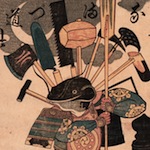|
goose fleet posted:A rather forceful blowjob Facial headblow to the crotch
|
|
|
|

|
| # ? May 15, 2024 16:43 |
|
goose fleet posted:What the gently caress is going on in this image Kama Swordtra
|
|
|
|
goose fleet posted:What the gently caress is going on in this image Man discovers this One Weird Trick to stop enemies from hitting them with a giant sword. Heteros hate him. e: I'm legitimately curious what the artist was trying to depict. Some dude just crashing into the other guy's torso in order to knock him down? It's so... deliberate. MisterBibs has a new favorite as of 23:31 on Feb 27, 2016 |
|
|
|
To be honest though, mashing your face into an unwashed medieval scrotum might not be preferable to death.
Carthag Tuek has a new favorite as of 23:59 on Feb 27, 2016 |
|
|
|
the only difference between a military sword and a civilian sword, prior to the 18th century, is that the first one is carried by a soldier, hand to heart
|
|
|
|
Best looking sword is the Heavy Ram-Dao, a sacrificial sword from Nepal. Unfortunately, it wasn't designed for combat, and was used to behead the sacrificed animal in one sword blow. http://art-of-swords.tumblr.com/post/19884769923/ram-dao-the-sacrificial-sword-the-ram-dao-is-a  It even made an appearance in the manga, Berserk. 
|
|
|
|
Anime in the history thread! Abandon ship!
|
|
|
|
imo anime is ahistorical
|
|
|
|
Anime was created in 40 BC to punish the western world for Rome invading their land
|
|
|
|
Much like italian pasta being a direct historical derivative of asian noodles, anime is a direct consequence of roman graffiti.
|
|
|
|
Manga, not anime! There's a whole lot of historically-accurate armor and weapons in it. Well, except for that Dragonslayer sword, which would weigh about 300lbs if it were real. 
|
|
|
|
 
|
|
|
|
Anime is bad (also manga)
|
|
|
|
So how about that interesting history stuff goons?
|
|
|
|
Say Nothing posted:Manga, not anime! If this was authentic damascus steel it would actually only weight 4.3 pounds hth.
|
|
|
|
|
SeanBeansShako posted:So how about that interesting history stuff goons? Here's an interesting thing: I just read about a Dutch+Danish linguist/archaeologist team (Guus Kroonen and Rune Iversen) who are looking into the pre-Germanic substrate hypothesis. So like, most languages in Europe are Indo-European. IE has branches into numerous languages, basically all languages in Europe that aren't Basque, Finnish, and I think one more. Anyway, there are some words and sounds in the Germanic languages (German, Dutch, English, Danish/Norwegian/Swedish, etc) that have very few, if any, cognates in the other IE languages. The substrate hypothesis is that these words come from a substrate – an earlier language that the Indo-Europeans assimilated. So apparently they've identified a few words that may be from the substrate – that is, a dead language that was spoken in northern Europe before IEs arrived and the proto-Germanic language started to form, so about 2.5k years ago. A bunch of substrate reconstructions are listed here: http://www.cranberryletters.com/pre-proto-germanic/ Now I'm not a linguist so I have no idea if it's plausible or not, but it's super cool anyway. Carthag Tuek has a new favorite as of 01:25 on Feb 28, 2016 |
|
|
|
^^ you also have several other uralic languages like the sami languages and hungarian.Decrepus posted:If this was authentic damascus steel it would actually only weight 4.3 pounds hth. is that more or less than 400lb of concrete? Munin has a new favorite as of 01:32 on Feb 28, 2016 |
|
|
|
Snapchat A Titty posted:So like, most languages in Europe are Indo-European. IE has branches into numerous languages, basically all languages in Europe that aren't Basque, Finnish, and I think one more. Finnish, Estonian, Hungarian, Sami, Meadow Mari, Hill Mari, Khanty, Mansi, Komi and probably a bunch of ones I'm forgetting are all Finno-Ugric languages and not at all related to the Indo-European languages. I'm also not a linguist and probably a bit full of poo poo somehow.
|
|
|
|
HEY GAL posted:the only difference between a military sword and a civilian sword, prior to the 18th century, is that the first one is carried by a soldier, hand Are you sure? It's my understanding at least with rapier type weapons that one kind was optimized for pure and only thrust (some people call those tucks but trying to type a sword by name is risky business) while the other was lighter and had some ability to cut on top of the usual
|
|
|
|
Finally, a subject I know about! What you have to remember about swords or any other weapon is that they are tools, and tools meant for specific jobs. There was an arms race between weapons and armor technology. Fighting someone in full plate armor called for a different weapon then fighting someone just wearing a linen doublet. There was also a matter of training and circumstances. Let's take the example of two knights fighting in full plate given above. They're using what's called half-sword You're not going to cut your opponent, and the armor was designed to make thrusts slide off to the side. You use your sword like a crow bar, sliding under the armpit or locking the elbow to force your oppponent down to the ground, orat least bind them in a difficult position so you can draaw your dagger and stab them between armor plates. There was also the matter of forcing them to surrender so you could ransom them back to their families. Curved blades, like a katana, were meant for cuts against lightly armored opponents. Most western swords were designed for thrusting, since cuts were less likely to do real damage to your opponent. Bear in mind, when I say cuts, I don't mean big sweeping swings like you see in a movie. Doing that leaves you defenceless to long, and you will die. I'm talking about draw cuts, like you would use to cut a steak. A good wool doublet will protect you from most cuts that aren't to the head, but a thrust is harder to stop. Of course, there were always exceptions. Every period manual had cuts included, becuse they were useful, but they primarily taught the thrust. Sabres are designed for cuts, since they're meant to be used from a moving horse. Fencing (and yes, it was absolutely called fencing in the period, even if you were using halberds) is all about technique and skill. It was based on scientific principles of geography, mathematics and even rhetoric, among other things. You absolutely blocked with the edge, though you normally try to use the stronger part of your blade against the weaker part of theirs. Not to break it, but to give you mechanical advantage. Swords were designed to block with the edge, you're not going to damage them. Sorry this was a little disjointed. I've been studying western martial arts for quite a while now, and would be happy to go on about whatever. In closing, here are some videos. This first one is pretty much a lesson in how not to fight, if you want to keep breathing. THere's no effort on either part to make sure there's an opening to advance, and both rely to much on speed and strength. https://youtu.be/tS19q-59hyk Comapre that with this video. Different weapons, but the exact same principles. Neither advances witout securing an opening, and nothing is forced. https://youtu.be/GFroPGvc5dc
|
|
|
|
FreudianSlippers posted:Finnish, Estonian, Hungarian, Sami, Meadow Mari, Hill Mari, Khanty, Mansi, Komi and probably a bunch of ones I'm forgetting are all Finno-Ugric languages and not at all related to the Indo-European languages. Yeah I shoulda said family or something. Not being a linguist is heck on my linguistic accuracy.
|
|
|
|
SeanBeansShako posted:So how about that interesting history stuff goons? Sure. John Franklin died from eating lead poisoned rations during his third expedition to the Canadian arctic searching for the Northwest Passage in 1847. In 1854, the Scottish explorer, John Rae, discovered the true fate of the expedition, but he was denied a knighthood for his discovery, because Lady Franklin, John Franklin's wife, was obsessed with maintaining her husband's image of a national hero, and Rae's discovery jeopardized that. Rae was basically the polar opposite of Franklin, who was a greedy rear end in a top hat who left his french and native guides to starve to death on his terrestrial expeditions. Rae, on the other hand, respected his guides' customs and actually discovered the final link to the Northwest Passage. He died alone and unremembered for a long rear end time.
|
|
|
|
This just popped in my head from a conversation I overheard, maybe someone can clear this up: I've heard that everything we know about the ancient druids basically comes from people who hated/destroyed them, and their own historical records either never existed or were completely eradicated. And anyone who follows the "druidic religion" is practicing something cobbled together out of fantastical myths.
|
|
|
|
BJPaskoff posted:This just popped in my head from a conversation I overheard, maybe someone can clear this up: I've heard that everything we know about the ancient druids basically comes from people who hated/destroyed them, and their own historical records either never existed or were completely eradicated. And anyone who follows the "druidic religion" is practicing something cobbled together out of fantastical myths. That's pretty much right. It is a fact that there were druids and they had rituals and stuff, but there's no evidence of what they did or how they did it. Pretty much anything specific you'll hear about druids is a later invention.
|
|
|
|
That's pushing it a bit far - the main source is Julius Caesar, who was actually fighting the druids. Anyone doing any kind of neopagan magic stuff, though, is probably taking over half of it from Gerald Gardner, who wrote after the Second World War and was not a scholar.
|
|
|
|
But are there any real facts in ol' Jules writings? Afaik that's it: Druids existed, they had rituals (probably related to forests), that's it....? Or?
|
|
|
|
Pretty sure a lot of contemporary paganism in the western world is just plain descended from Wicca, which is literally a made up religion that a guy fabricated in the 1950's. He claimed he was talking to people who had been practicing magic in secret but that turned out to be bullshit.If memory serves it was 100% provably bullshit. Other parts of contemporary paganism are based on concepts that ancient religions had rather than direct lines from them. Other parts are...well, literally crazy people just being crazy and believing they're wizards that talk to faeries. In the case of ancient druids their histories and religions were generally passed down orally. There just weren't written records so once the Romans started to kick their faces in there was little chance of it surviving. If memory serves druids were generally also leaders of various types, which got them targeted something fierce. When they died their histories died with them.
|
|
|
|
hard counter posted:Are you sure? this is tilly's sword, it's a closeup of the handle but you can definitely see the blade 
|
|
|
|
ToxicSlurpee posted:Pretty sure a lot of contemporary paganism in the western world is just plain descended from Wicca, which is literally a made up religion that a guy fabricated in the 1950's. He claimed he was talking to people who had been practicing magic in secret but that turned out to be bullshit.If memory serves it was 100% provably bullshit. Yes, hella agreed. I was just looking for more sources cause I love reading about old stuff. But speaking of folk-magic and folk-wisdom, I'm definitely not an expert, but I've read a bit here and a bit there, and there's no system at all to it. I know that sounds counter-intuitive in a way, but I mean like if say herbs A + B and prayer C together can cure disease D or whatever, you'd figure that eventually that cure would have spread to all countries. Even if only through wise women/men? Weirdly, every region has its own sytem of folk magic.
|
|
|
|
Herb A or B may not grow everywhere, or the gods being petitioned may be not be worshiped, or maybe the local witches from one side of Lake Baikal hate the ones from the other side, etc. That and folk remedies tend to have a substantial component of the placebo effect, so they're not really useful if the person doesn't really trust it.
|
|
|
|
HEY GAL posted:about proto-rapiers? yes i am. you're not going to be able to sword a guy in plate armor anyway and most soldiers wore civilian clothing I when I said mail I meant chain and the like. Even a dude in full plate would probably use chain or lesser around joints where inflexible plate would be less appropriate. Not everyone on the field could go up all the way to full plate in any case. Lighter civilian dueling rapiers were modestly prone to breaking inside a soft person from the sources I've read, the ones with a military use in mind were made to be heavier to withstand the wear and tear of more rigorous use where it'll encounter denser materials or just plain more force as during a mounted charge. e: I should clarify that when I said some call the the heavier kind a tuck, I didn't mean strictly the ones with the 'S' shape on the cross guard or similar. The difference has more to do with the blade than what kind of hilt it has. Either way, what about boar-swords and the like? Those swords would be too specialized for civilian hunting to be of practical value to a soldier.   The heavy lugs on top were there to prevent the hunted animal from finishing its charge and goring the hunter despite being impaled. The design on this one is kind of funky but they usually had a screw-type point to really skewer whatever beast they were hunting. hard counter has a new favorite as of 07:56 on Feb 28, 2016 |
|
|
|
Jaramin posted:Herb A or B may not grow everywhere, or the gods being petitioned may be not be worshiped, or maybe the local witches from one side of Lake Baikal hate the ones from the other side, etc. That and folk remedies tend to have a substantial component of the placebo effect, so they're not really useful if the person doesn't really trust it. welll the herbs in scandinavia are 10x more effective than the herbs in mainland europe so.
|
|
|
|
Snapchat A Titty posted:welll the herbs in scandinavia are 10x more effective than the herbs in mainland europe so. But the gods there only care about people praying to them 1/10th as much, so it evens out in the end.
|
|
|
|
Snapchat A Titty posted:But are there any real facts in ol' Jules writings? Afaik that's it: Druids existed, they had rituals (probably related to forests), that's it....? Or? Caesar goes into quite a bit of detail about the druids and their practices. If you're asking how accurate it is, you're better off asking in the ancient history thread, but while I've always got the impression Caesar's treated as a reliable witness, it's by definition pretty difficult to tell how reliable a single source is. The really badass details, like the final exam being shut in a half-full coffin with rocks on your chest, composing a poem and meoldy in complex meter, with a 2/5 failure rate punished by death... may be a little exaggerated.
|
|
|
|
Jaramin posted:But the gods there only care about people praying to them 1/10th as much, so it evens out in the end. Haha yes the norse gods basically just do their own thing and are kindof annoyed when humans get in their way.
|
|
|
|
Funzo posted:Finally, a subject I know about! Real knight's swords--actually all European ones--are amazingly lightweight. How light? 2-3 pounds/1-1.3 kilos. A good swordsmith can create a weapon that works so well with your shoulder and arm that it simply feels like an extension of yourself. If the sword is too heavy, you'll tire out too quickly. If it doesn't really fit you, you'll put more work into it than you would if it was properly balanced for you and tire, though not quite as fast.
|
|
|
|
hard counter posted:Only a wiki source, but this was the particular maker https://en.wikipedia.org/wiki/Ulfberht_swords in the documentary iirc. You mean the Ingelrii swords? https://en.wikipedia.org/wiki/Ingelrii
|
|
|
|
Not the specific one I was thinking of since there's dozens and dozens of different makers (some ID'd in cyrillic script, some using Norse runes and others with just abstract marks probably intended as maker's stamps) that can also be found of similar construction.
|
|
|
|
PYF Historical Stultifying Conjecture. E: for content, there have been at least three famous defenestrations in Prague.
|
|
|
|

|
| # ? May 15, 2024 16:43 |
|
dobbymoodge posted:PYF Historical Stultifying Conjecture. At least two of which kicked off a major war along religious fault lines.
|
|
|








































